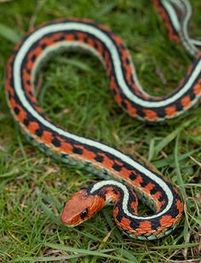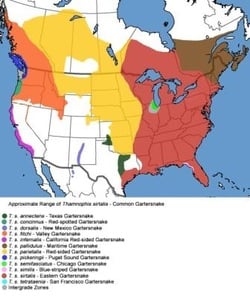California Red-Sided gartersnakeThamnophis sirtalis infernalis |

Custom Search
|
|
The California Red-Sided gartersnake (Thamnophis sirtalis infernalis) is like their common name indicates found in California. Found along the coast ranges and east of the San Francisco Bay to just below the Monterey Bay and south to Humboldt County.
They are very good swimmers so they prefer most often habitats near streams, ponds, ditches or marshes, they will try to escape into the water when threatened. But these snakes are also present in a variety of habitats including forests, grasslands, farmlands, mixed woodlands, and chaparral. They are considered a subspecies of the Common Gartersnake (Thamnophis sirtalis), which has the largest distribution of any gartersnake, ranging from the west coast to the east coast and north into Canada, they are found farther north than any other snake species in North America. The species lifespan in the Wild is on average 2 to 4 years, but in captivity, they can live up to 6 to 10 years or maybe up to 20 years. They are primarily active during the day, hunting and basking in the sun to regulate their body temperature.

The California Red-Sided garter is a medium-sized snake with female snakes being larger than the males. The adult specimens reach 18 to 55 inches in length (46 to 140 cm), but their average size is around 36 inches (91 cm).
They have relatively large eyes when compared with other gartersnake species, and the head is red or orangish and only slightly wider than the neck, They possess keeled dorsal scales. The California Red-Sided gartersnake ground color ranges from dark olive to black and their dorsal stripe is wide and well-defined, ranging from bluish to yellowish in color. They also have light stripes along the lower sides, sometimes these aren't very distinct and often blend in with the belly color that ranges from yellow-green or blue. Just above the lateral stripes along the sides, there are also red bars alternating with the ground color. The juvenile snakes are similar in appearance to adults. When handled or if disturbed, they display a typical gartersnake behavior and often release foul-smelling cloacal contents and musk. They may also coil and strike. They often use these techniques to escape when attacked by their predators like hawks, crayfish, crows, raccoons and even other snakes like the coral snake and the California King Snake. Venom / Bite It was a popular belief that garter snakes were non-venomous snakes, but some recent studies have shown that garter snakes are indeed venomous. They have toxins in their saliva which can be deadly to their prey and a bite might produce a mild reaction in humans. Despite having enlarged teeth, garter snakes lack an efficient means of injecting venom. The garter snakes need to “chew” their food, so the venom is delivered into the prey’s blood. Unlike other highly venomous snakes like pit vipers that can inject venom deep into the prey using their very long and hollow fangs. But the fact remains that they are harmless to humans because their venom isn’t very toxic and they lack the ability to deliver it efficiently. Diet / Feeding The California red-sided gartersnake feeds mainly on small mammals, amphibians, fish, reptiles, slugs, earthworms, leeches, birds and birds eggs. They are also able to kill and eat adult Pacific newts (Taricha) which are deadly poisonous to most predators. They also store the newt's toxin to protect themselves against predators. Reproduction The mating season of the species occurs in the early spring and maybe, autumn. They are a viviparous snake species and females give birth to live baby snakes. The clutch size typically ranges from 8 to 20 young. The hatchlings are born in the mid-summer to early fall after a gestation period of 60 to 90 days. They are usually 5 to 8 inches long (12 to 20 cm), and become independent from the moment of birth. Juveniles are born with paler colors and most are born yellowish and become bluer and their colors brighter as they mature and successively shed their skin. The California red-sided gartersnake reaches sexual maturity at the age of 2 to 3 years. Conservation / Threats The California red-sided gartersnake as yet to be assessed for the IUCN Red List. The California red-sided garter snake has no special status, although some of the other subspecies of common garter snakes (T. sirtalis) are considered rare, threatened, or even endangered like the San Francisco gartersnake. The habitat loss and overcollection for the pet trade (they are very popular as pets) are the biggest threats to most garter snake species.
|
Scientific classification |
© 2014 Snake Facts About Us | Privacy Policy | Contact




